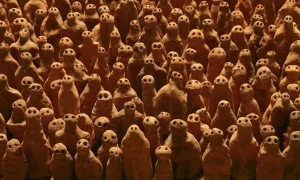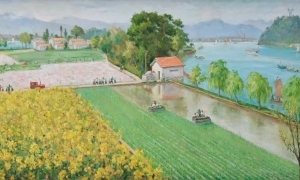Chen Tianzhuo
陈天灼
陈天灼的作品植根于宗教、反思和献身的理念中。艺术家创作了其独特的艺术语言,融入了传统的宗教符号和带有其极致个人风格的图像系统,用戏谑的手法试图构建一个虚拟的当代宗教体系。他在照片的影印件上作画俨然成为他想象力殿堂的重要表达方式。这些绘画展示出艺术家独具个人趣味的当代创作体系,与西方宗教艺术有异曲同工之妙。
Born in 1985, lives and works in Beijing,
Represented by Star Gallery, Beijing.
The work of Tianzhuo Chen gravitates around the ideas of religion, contemplation and devotion. The artist creates a whole new language, combining traditional worship symbols with a new body of objects and images as part of his new personal iconographic repertoire. Tianzhou comprehensively articulates the features of his fictitious religion, which, at the end of the day, could be as valid as any other else. His drawings on photocopies are the devotional paintings of his imaginary temples. They show to the viewer stories and miracles of Tianzhou’s contemporary deities, echoing compositions typical of the western religious art.
Tianzhuo SS Lookbook 春夏时装片
Chen Tianzhuo 陈天灼|Lightbox灯箱, 摄影|2012 |106 x 154 cm
Cheng Ran
程然
Born in 1981, lives and works in Hangzhou,
Rrepresented by Galerie Urs Meile, Beijing and Lucerne.
As suggested from the title of this video installation, horses are usually divided in three different categories - hot blood, warm blood and cold blood - depending on their breeding. To each one of these classifications, invisible to the naked eye, are commonly associated different temperamental characteristics. These tempers are unchanging, intangible and invisible, but even so, we can somehow perceive the differences between hot and cold. Cheng associates this hidden elements that drift in different directions of the emotional states, with the spiritual world of human beings, unintelligible, but still immensely indispensable. The artist dedicates a projection to each blood group, confirming and denying, trough carefully chosen images, the qualities generally associated to them. Together, the three videos offer up a striking mosaic, revealing a horse’s temperament to be as varied as it is unknowable, despite the classifications. In this piece Cheng confront us with our enduring desire to perceive with the eye what ordinarily remains hidden from view, highlighting at the same time the disconnection between what we see and what we are looking for.
如标题所言,可以根据品种将马分为热血、温血和冷血三种。马的性情脾气是稳定而无形的,尽管无法用肉眼区分,,我们却或多或少能够体会到三种马之间的细微差别。程然将马隐藏的个性与马的情感联系起来,正如人的精神世界,不可触及,却又不可或缺。艺术家用三频录像分别表达热血、温血和冷血的马,通过精心挑选的影像,表现了三种马的不同特性。三屏影像结合在一起,如同构成了一幅精美的马赛克图案,呈现出马不为人知却截然不同的个性脾气。艺术家试图为观众揭示隐藏在我们视线范围之外的东西,同时也强调了我们所见以及希望所见之间的无关联性。
Hot Blood Warm Blood Cold Blood (edition of 6)
Cheng Ran程然|Channel HD video, color, sound|2011|8’08”
Gao Ru Yun
高入云
Born in 1988, lives and works in Shanghai,
Represented by M Art Center, Shanghai
Winner of the 2011 M50 Creative Awards, this series of motion installations has at its core the exploration and description of the space that surrounds us. Through simple and linear movements performed by wires connected to small engines and mounted in wooden frames or supports, Gao gives life to space. When the engines are running and the wires twist and bend, the eyes play tricks on the viewer, inducing one to believe that the space itself is stretching and shrinking at the rhythm of this mechanical choreographies.
高入云是2011年M50创意新锐评委会大奖得主。这一系列运动装置试图探索和表达我们周遭的空间关系。艺术家将铁丝连接小型发动机,并将它们固定在木型支架上,通过发动机动力铁丝开始进行简单的线性运动,同时也如同给周遭的空间赋予了生命一般。随着发动机的运转,铁丝不断扭曲翻转,这也是艺术家营造的视觉玩笑,使观者误以为空间本身在随着机器的节奏而伸缩翻转。
Space 舞动的空间
Gao Ru Yun高入云|Mixed Media综合材料 |2011|15x25x10cm x3
Nandan Ghya
Born in 1980, lives and works in Rajasthan,
Represented by Exhibit320. New Delhi.
Jaipur-based contemporary artist Nandan Ghiya’s hybrid art deals with the narratives of the constant conflict between the present and the past and, in this occasion, between traditions and the new technologies embedded in the contemporary lifestyle. Her work is inspired both by her cultural baggage rooted in traditional Indian art, and the symbols of nowadays consumer society. The work focuses on ethnic groups from the past, on people who lived without any awareness or suspicion of the staggering advancements the humanity would have achieved in terms of digital technology. Questioning India’s present value systems, the artist is concerned about the overwhelming invasion of pixels and digital imaginary which is increasingly spacing the new generations out from the collective memory related to their ancestors and traditions. In this mixed media installation, Nandan Ghiya displays vintage portraits that have been defaced by painted pixels that hide their features of the people depicted. These images, which are also arranged in a pixel-like distribution on a Rajasthani wall, remind us of old family photographs and, at the same time, of profile pictures of an imaginary social network, downloaded from the past.
Nandan Ghiya生活在印度斋普尔,他的多元化艺术作品始终关注当下和过去的冲突、以及传统和伴随我们当代生活方式的新技术之间的冲突。艺术家的作品不仅吸收了传统印度艺术的文化土壤,同时也包含了当下物质社会的符号象征。这组作品将焦点聚集于上一代印度人,科学技术的快速发展以及对人类生活的快速推动都是他们这一代人始料未及的。像素和数字化技术正猛烈地冲击着全新一代的年轻人,以至于他们的集体记忆已与他们的长辈和先祖相去甚远,艺术家在此作品中表达了对这一现状的担忧,同时也拷问着印度当今的价值体系。在这件多媒体装置中,Nandan Ghiya展示了古老的印度人像照片,但却用技术化处理的像素遮盖了人物的主要特征,通过这样的方式试图提醒观众老式摄影的存在,同时这些照片也帮助我们通过想象还原过去的社会生活。
Thumbnail, Pixel Atacks - Rajasthan, from the deFacebook Series
Nandan Ghya |Acrylic, old frames, old photographs in collage|2010 - 12|Size - Medium - Variable, set of 60 images in the installation.
Aki Kondo
Born in 1987, lives and works in Tokyo,
Represented by ShugoArts., Tokyo.
The dynamic compositions and vivid colors in the paintings of the Hokkaido born Aki Kondo, are always concealing deep and complex stories. In her characteristic multiple panels works, the artist intertwines characters and details that inspire the viewers’ imagination, suggesting unusual and unexpected narratives. This particular work depicts the act of eating, as one of the most intrinsic and perennial components of every living being. An ironic and merciless idiosyncrasy will always rule this essential part of our existence, having us eating other living organisms in an inevitably constant quest for energy.
The contemplation of nature, its roots and meanings, have inspired much of Kondo's work. In a whirlpool of colors applied on the canvas in bold brush strokes, the artist condenses the past, the present and the future of the eating history. Even when the whole world will change around us, we will still be linked to our primal nature by our eaters/eaten necessary condition, reminding us the unalterable backbone of our essence.
出生在日本北海道的Aki Kondo最擅长运用动态的构图和鲜艳的色彩来阐述其背后深入复杂的故事。在她具有标志性的多联油画中,艺术家运用大量符号和细节来激发观者的想象,讲述背后出乎人意料的叙事。作品描绘了进食的动作,吃是人类生存所必须的要素。由于人类对于能量的持续性需求,不可避免的需要实用其他动物和生物,这也是人性讽刺而残忍的本质。
Kondo的作品大多探讨自然的本质,起源和意义。通过大胆的笔触和丰富的用色,艺术家将吃的过去现在和未来浓缩在画布上。即使我们生存的世界改变了,我们依然不可能改变存在于人性中对吃的欲望,艺术家试图通过这件作品提醒我们这一无法改变的人性根本。
An Earth of Eating
Aki Kondo |oil on panel|2012 |227.3x436.2cm
Li Jun
李俊
Born in 1977, lives and works in Chengdu,
Represented by M97, Shanghai,
The protagonist of this series by photographer Li Jun is a symbolic dust, the layers of a dirtiness that envelope the furniture in his Chengdu apartment bringing with them the evidence and the melancholy of past times. The haunting marks left on the surfaces by the now absent objects, are the unmistakable evidence of the ephemeral existence that characterizes our present environment and our lives. In Buddhism, the fundamental concept of "impermanence" teaches that all things are in a constant state of change. Time, existence, and consciousness itself are nothing more than a series of eternally changing impermanent instants. Li Jun focuses in his works the frustration caused by the frantic lifestyle of the modern China, and the disquieting uneasiness provoked by a constantly changing environment. The artist uses the dust to remind us of the unstoppable concrete high-rise that surrounds us as well as to represent the baton exchange between past and present.
“尘埃”是李俊这组摄影作品的主角。这是艺术家成都公寓家具上日积月累的灰尘,真实地见证了过去的时光。从灰尘表面留有的形状印迹证可依稀判别曾经放置在其上的物体,这些印迹也无可置疑地证明了我们周遭环境在不断变化中。“无常”是佛教的核心思想,时刻提醒人们一切事物都在时时变化。时间、存在和意识本身也不过是一系列不断变化的瞬间罢了。李俊的作品关注当代中国疯狂的生存方式和随之产生的问题,以及不断改变的生存环境给人们造成的不安定感。这些灰尘一方面提醒我们身边每天拔地而起的高楼从不间断,另一方面也将过去与当下的碰撞呈现在观者面前。
Film Strip ( Impermanent Instant)底片( 无常时 )
Li Jun李俊 |2010|6pieces 70x87.5cm
Liao Guohe
廖国核
Born in 1977, lives and works in Changsha,
Artist represented by Boers-Li Gallery, Beijing.
Milk Cow Licking Broken car 奶牛舔破车
Liao GuoHe 廖国核|Acrylic on canvas布面丙烯 |2011|220 x 192cm
Yu Cheng-Ta
余政达
Born in 1983, lives and works in Taipei,
Represented by Chi-Wen Gallery. Taipei.
If we were asked to express our perceptions and experiences related to a particular place, every individual would respond in a very different way but, nevertheless, a common stratum would be met by all the answers.
In “A Dialogue between David and David” the Taiwanese artist Yu Cheng-Ta displays a sculptural installation which embodies his personal perception of New York.
Each city can be represented in diverse and kaleidoscopic ways, mixing up ever-changing images drawn from our affective memories with collective imaginaries and clichés. The nature and aesthetics of this installation are then discussed by the artist and a friend of his, who shared with Yu Chang-Ta experiences related to New York. Through their conversations, they attempt to reconstruct and analyze the memories that triggered the artist’s perception of the city, shifting his representation from subjective to collective.
当被问及对于某一个地方的印象和感受时,几乎一百个人就会给出一百个答案。然而在这些答案中却总会有某些相同之处。
在这件作品中,台湾艺术家余政达用一组雕塑装置来呈现他个人对于纽约这座城市的印象。每座城市都可以用各种方式来描绘,兼有我们有效记忆中时时变化的影像、人云亦云的想象和那些陈词滥调。艺术家和曾同他一起身在纽约的朋友一同讨论了这件装置作品的属性和美学,通过对话,他们试图重建和分析艺术家对于城市的理解,将他主观的表达转化为集体的记忆。
A Dialogue between David and David 大卫与大卫的对话
Yu Cheng-Ta 余政达|Installation影像空间装置|2012




























